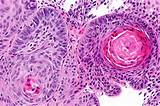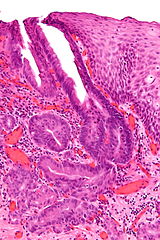Esophageal cancer pathophysiology
 From Wikidoc - Reading time: 4 min
From Wikidoc - Reading time: 4 min
|
Esophageal cancer Microchapters |
|
Diagnosis |
|---|
|
Treatment |
|
Case Studies |
|
Esophageal cancer pathophysiology On the Web |
|
American Roentgen Ray Society Images of Esophageal cancer pathophysiology |
|
Risk calculators and risk factors for Esophageal cancer pathophysiology |
Editor-In-Chief: C. Michael Gibson, M.S., M.D. [1] Associate Editor(s)-in-Chief: Hadeel Maksoud M.D.[2]
Overview[edit | edit source]
The pathophysiology of esophageal cancer depends on the histological subtype, whether squamous cell carcinoma or adenocarcinoma.
Pathophysiology[edit | edit source]
- The esophagus is lined by nonkeratinized stratified squamous epithelium.
- This lining is maintained as long as there are no risk factors that can lead to a metaplastic change.
Esophageal Squamous Cell Carcinoma[edit | edit source]
- The risk factors for esophageal squamous cell carcinoma include smoking and alcohol.[1][2]
- When alcohol and tobacco are combined they have a synergistic effect and the risk for esophageal squamous cell carcinoma is higher.
- Alcohol is able to dissolve fat soluble compounds, like that of the esophageal epithelium.
- Tobacco carcinogens such as aromatic amines, nitrosamines and polycyclic hydrocarbons are, therefore, able to penetrate the esophageal epithelium deeper when in the presence of alcohol.
- Alcohol is also able to decrease the metabolic activities of epithelial cells by damaging DNA.
- When the cellular DNA is damaged, the cell cannot undergo detoxification and protect itself from oxidative damage.
- Oxidation leads to inflammation of the squamous epithelium.
- Continuous irritation of the epithelium leads to dysplasia and in situ malignant transformation.
Esophageal Adenocarcinoma[edit | edit source]
- The risk factors for esophageal adenocarcinoma include gastroesophageal reflux disease and obesity.[3][4][5][6][7]
- The chronic reflux of gastric acid and bile at the gastroesophageal junction leads to the irritation of squamous epithelium lining the esophagus.
- Chronic irritation leads to metaplasia of esophagus.
- The lining of the esophagus changes from non-keratinized stratified squamous epithelium to columnar epithelium.
- This condition is called Barrett's esophagus .
- The progression of Barrett's esophagus to adenocarcinoma is associated with changes in genetic and protein structure, as well as gene expression.
- These mutations include:
- In addition, obesity is implicated in the development of esophageal adenocarcinoma.[10]
- Patients with central obesity tend to have hypertrophied adipocytes and inflammatory cells within their fat deposits.
- This creates a microenvironment within the adipocyte that promotes tumor development through the release of adipokines and cytokines.
- Adipocytes potentiate tumor expansion by supplying energy to support the tumor's growth.
Pathology[edit | edit source]
Gross pathology[edit | edit source]
Squamous cell carcinoma or adenocarcinoma of the esophagus may appear as:[11]
- Flat and irregular plaque
- Polypoid lesion
- Ulcerating, fungating mass.
- Location:
- Squamous cell carcinoma is usually found in the mid-third of the esophagus.
- Adenocarcinoma is usually found in the lower third of the esophagus near the gastric opening.
- Location:
Microscopic pathology[edit | edit source]
Nuclear atypia of malignancy:[edit | edit source]
- Found in both types:[12]
Squamous cell carcinoma:[edit | edit source]
- Atypical squamous cells invade the basement membrane
- Cytology of squamous cells:
- Eccentric nucleus
- High mitotic activity
- Eosinophilic cytoplasm
- Squamous whorls or keratin pearls
- Cytology of squamous cells:

Adenocarcinoma[edit | edit source]
- Atypical adenomatous cells show:[13]
- Invading cell clusters or glands
- Cribriforming
- Desmoplasia
- Invasion into submucosa

References[edit | edit source]
- ↑ Napier KJ, Scheerer M, Misra S (2014). "Esophageal cancer: A Review of epidemiology, pathogenesis, staging workup and treatment modalities". World J Gastrointest Oncol. 6 (5): 112–20. doi:10.4251/wjgo.v6.i5.112. PMC 4021327. PMID 24834141.
- ↑ Mao WM, Zheng WH, Ling ZQ (2011). "Epidemiologic risk factors for esophageal cancer development". Asian Pac. J. Cancer Prev. 12 (10): 2461–6. PMID 22320939.
- ↑ Tilanus HW (1995). "Changing patterns in the treatment of carcinoma of the esophagus". Scand. J. Gastroenterol. Suppl. 212: 38–42. PMID 8578231.
- ↑ Jankowski JA, Wright NA, Meltzer SJ, Triadafilopoulos G, Geboes K, Casson AG, Kerr D, Young LS (1999). "Molecular evolution of the metaplasia-dysplasia-adenocarcinoma sequence in the esophagus". Am. J. Pathol. 154 (4): 965–73. doi:10.1016/S0002-9440(10)65346-1. PMC 1866556. PMID 10233832.
- ↑ Koppert LB, Wijnhoven BP, van Dekken H, Tilanus HW, Dinjens WN (2005). "The molecular biology of esophageal adenocarcinoma". J Surg Oncol. 92 (3): 169–90. doi:10.1002/jso.20359. PMID 16299787.
- ↑ Ireland AP, Clark GW, DeMeester TR (1997). "Barrett's esophagus. The significance of p53 in clinical practice". Ann. Surg. 225 (1): 17–30. PMC 1190601. PMID 8998117.
- ↑ Nieman KM, Romero IL, Van Houten B, Lengyel E (2013). "Adipose tissue and adipocytes support tumorigenesis and metastasis". Biochim. Biophys. Acta. 1831 (10): 1533–41. doi:10.1016/j.bbalip.2013.02.010. PMC 3742583. PMID 23500888.
- ↑ Enzinger PC, Mayer RJ (2003). "Esophageal cancer". N. Engl. J. Med. 349 (23): 2241–52. doi:10.1056/NEJMra035010. PMID 14657432.
- ↑ Wu C, Hu Z, He Z, Jia W, Wang F, Zhou Y, Liu Z, Zhan Q, Liu Y, Yu D, Zhai K, Chang J, Qiao Y, Jin G, Liu Z, Shen Y, Guo C, Fu J, Miao X, Tan W, Shen H, Ke Y, Zeng Y, Wu T, Lin D (2011). "Genome-wide association study identifies three new susceptibility loci for esophageal squamous-cell carcinoma in Chinese populations". Nat. Genet. 43 (7): 679–84. doi:10.1038/ng.849. PMID 21642993.
- ↑ Nieman KM, Romero IL, Van Houten B, Lengyel E (2013). "Adipose tissue and adipocytes support tumorigenesis and metastasis". Biochim. Biophys. Acta. 1831 (10): 1533–41. doi:10.1016/j.bbalip.2013.02.010. PMC 3742583. PMID 23500888.
- ↑ Sugarbaker, David (2015). Adult chest surgery. New York: McGraw-Hill Education. ISBN 0071781897.
- ↑ "Squamous cell carcinoma of the esophagus".
- ↑ "Esophageal adenocarcinoma".
Licensed under CC BY-SA 3.0 | Source: https://www.wikidoc.org/index.php/Esophageal_cancer_pathophysiology9 views | Status: cached on November 28 2025 00:59:28↧ Download this article as ZWI file
 KSF
KSF